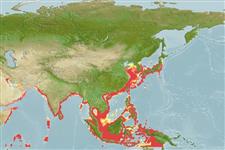Common names from other countries
Classification / Names / Names
Namen | Synonyme | Catalog of Fishes (gen., sp.) | ITIS | CoL | WoRMS
Environment: milieu / climate zone / depth range / distribution range
Ökologie
Pelagisch; brackwasser; tiefenbereich 1 - 100 m (Ref. 101307). Tropical, preferred 23°C (Ref. 107945); 41°N - 11°S, 47°E - 142°E
Indo-West Pacific.
Length at first maturity / Size / Gewicht / Alter
Maturity: Lm 1.8, range 2 - 1.8 cm Max length : 2.4 cm BL Männchen/unbestimmt; (Ref. 409); 3 cm BL (female)
Phyto- and zooplanktivorous (Ref. 128452). Epipelagic, inhabits shallow coastal waters over muddy bottoms (Refs. 409, 128452). Found in a mangrove vegetate area (Ref. 121475).
Members of the order Decapoda are mostly gonochoric. Mating behavior: Precopulatory courtship ritual is common (through olfactory and tactile cues); usually indirect sperm transfer.
Chan, T.Y. 1998. (Ref. 409)
IUCN Rote Liste Status (Ref. 130435)
CITES Status (Ref. 108899)
Not Evaluated
Not Evaluated
Nutzung durch Menschen
Fischereien: kommerziell
FAO - Aquakultur: production; Fischereien: landings, Artbeschreibung | FishSource | Sea Around Us
Tools
Internet Quellen
Estimates based on models
Preferred temperature
(Ref.
115969): 20.5 - 29.1, mean 28.2 (based on 1684 cells).
Widerstandsfähigkeit
hoch, Verdopplung der Population dauert weniger als 15 Monate. (K=1.3-1.8).
Prior r = 1.19, 95% CL = 0.79 - 1.79, Based on 3 data-limited stock assessments.
Verwundbarkeit
Low vulnerability (10 of 100).
